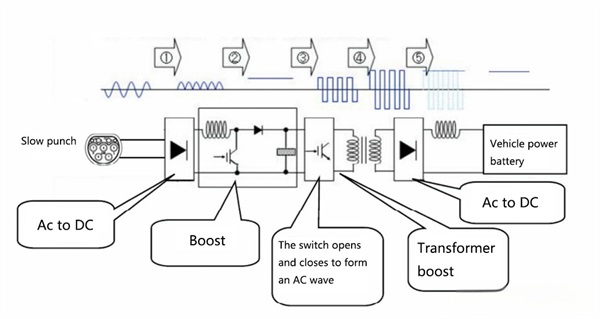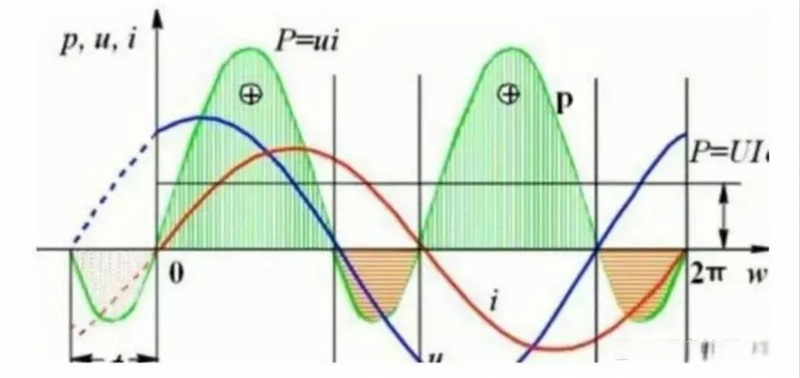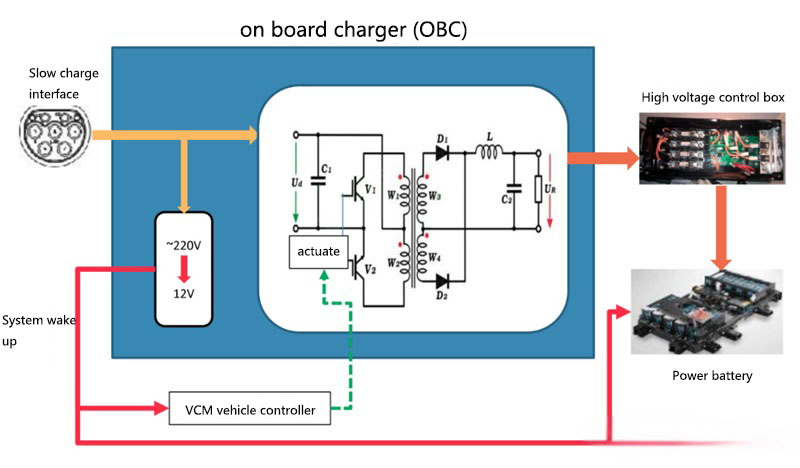OBC is a power electronic device for charging the car power battery, that is, the On Board Charger, referred to as OBC. The use of high-frequency switching power supply technology, the main function is to convert AC 220V to high voltage direct current to charge the power battery to ensure the normal running of the vehicle. At the same time, the vehicle charger provides corresponding protection functions, including overvoltage, undervoltage, overcurrent, undercurrent and other protective measures, when the charging system is abnormal, it will cut off the power supply in time.

Inside the car charger can be divided into 3 parts:
Main circuit, control circuit, wiring harness and standard parts

Transformation principle:
220Vac is filtered by EMI filter circuit, rectified by an AC-DC converter, the AC is rectified to DC, and then boosted by PFC power factor calibration circuit, and then sent to the switch and transformer frequency conversion boost. After LLC is rectified and filtered for the second time, high voltage DC is output to charge the power battery (220Vac rectified to 310Vdc for the first time, the voltage is not enough, and the voltage should be boosted and converted twice).
1. Main circuit: the main circuit circuit can usually be divided into two stages, the former stage is the power factor correction PFC module, improve the input power factor and suppress high harmonics; The rear stage is the DCDC converter, that is, the LLC module, which meets the requirements of current and voltage for battery charging and realizes electrical isolation (PFC: power factor corrector, which improves the utilization of electricity when alternating current is converted to direct current. Reduce power loss during the conversion process, so that the voltage and current phase frequency are consistent)


2. Control circuit: The control circuit completes signal reception and charge control through sensors, ECU and IGBT drivers.
Function: Control the switch of MOS tube, communicate with BMS, monitor the status of charger, shake hands with charging pile and other functions.

3. Wiring harness and standard parts: used for the connection of main circuit and control circuit, fixed components and circuit boards.
Communication
Power indicator: When the AC power is switched on, the power indicator is on.
Professional
When the charger turns on the battery and enters the charging state, the charging indicator lights up.
Warn
Alarm indicator lights up when there is a fault or wrong operation inside the charger
The fault information of the on board charger will be reported to the bus through the CAN bus, and the fault information CAN be found through the CAN bus.
Common faults:
1. The 12V low voltage power supply is abnormal. When the 12V module of the charger is abnormal, the BMS and meter cannot communicate with the charger because there is no wake up signal.
Judgment method: When 12V is not powered on, the simplest way to judge is that when AC is powered on, the battery does not make the sound of the relay closing, which is generally 12V abnormal. It is necessary to check the safety and relay of charging wake-up in the low-voltage safety box, and whether the charger terminal has lost the needle.
2, the battery voltage detected by the charger does not meet the requirements. The problem is that in the charging process, the BMS can work normally, but the charger needs to detect the power battery voltage before the work starts. When the power battery voltage is within the working range, the vehicle charger can work normally, otherwise the charger thinks that the battery does not meet the charging requirements.
Judgment method: This situation is common for the high voltage plug-in terminal withdrawal pin or high voltage insurance fuse, or the battery voltage exceeds the working range.
3, the charger detection and charging pile handshake is not normal. During the working process, the charger will detect the handshake signal between the charging pile and the charger. When it is judged that the CC switch is disconnected, the charger thinks that the charging gun will be pulled out at this time, and will stop working at this time to prevent plugging and removing with power, and improve the life of the charging gun terminal.
Next:32pcs 320ah lifepo4 battery and 36V battery charger were shipped to canada
Previous:How to distinguish between lithium-ion battery chargers and lead-acid chargers?
Contact Person: Miss. Kiki
| WhatsApp : | +8617763224709 |
|---|---|
| Skype : | +8617763224709 |
| WeChat : | +8617763224709 |
| Email : | kiki@lifepo4-battery.com |